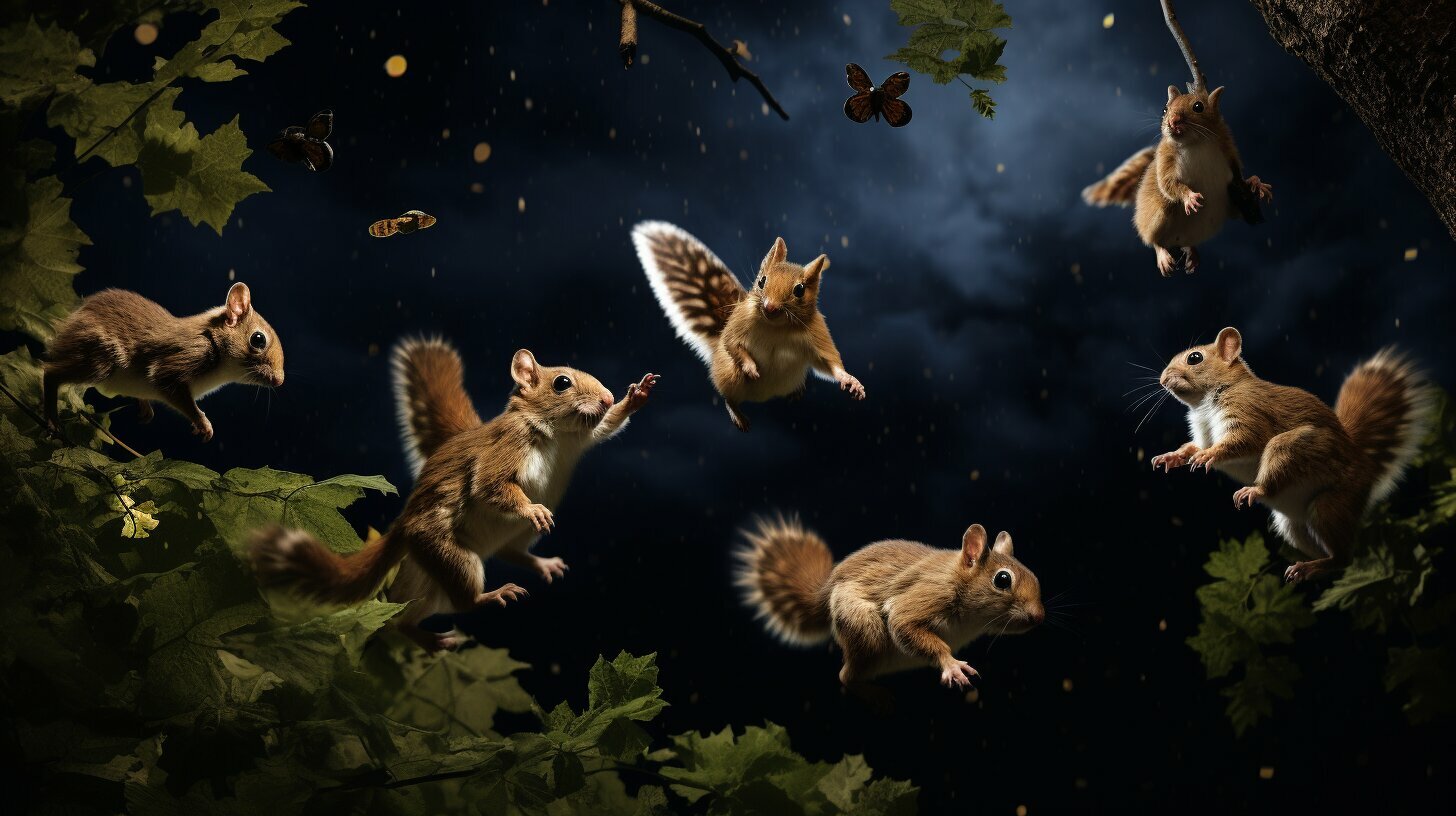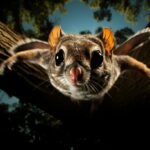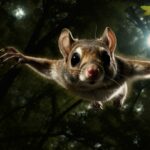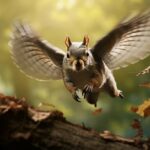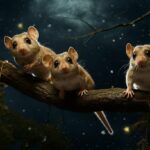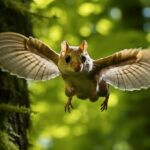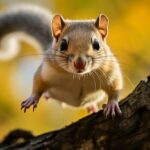Flying squirrels exhibit unique and intriguing behavior that sets them apart from other mammals. These small creatures are known for their gliding abilities, using a flap of loose skin called a patagium to soar through the air. With the ability to make 180-degree turns in mid-air and land safely on their padded feet, flying squirrels have mastered the art of evading predators and navigating their environment.
Found across North America, Central America, and parts of Asia, flying squirrels make their homes in tree cavities. They are skilled gliders, capable of covering impressive distances, with some species able to glide up to 295 feet. As nocturnal creatures, they have adapted to life in the dark with their large eyes and the unique ability to fluoresce at night.
When it comes to their diet, flying squirrels are not picky eaters. They feed on a variety of foods, including insects, seeds, nuts, fruit, and even carrion. While some species of flying squirrels have stable populations, others face threats from habitat destruction and hunting.
In North America, two native species of flying squirrels are found: the northern flying squirrel and the southern flying squirrel. These fascinating creatures have developed unique behaviors to ensure their survival, such as scurrying to the other side of a tree trunk after a glide to avoid predators. In captivity, they can live up to 10 years.
Humans have long been captivated by the abilities of flying squirrels and have drawn inspiration from them. In fact, scientists and engineers have developed suits that mimic the gliding behavior of these remarkable creatures.
Key Takeaways:
- Flying squirrels have a flap of loose skin called a patagium that allows them to glide through the air.
- They can make 180-degree turns mid-air and land safely on their padded feet.
- Flying squirrels are nocturnal and have adapted to life in the dark with large eyes and the ability to fluoresce at night.
- They have a diverse diet that includes insects, seeds, nuts, fruit, and carrion.
- Some species of flying squirrels are threatened by habitat destruction and hunting.
The Gliding Adaptation and Movement of Flying Squirrels
The ability of flying squirrels to glide effortlessly through the air is a result of their remarkable adaptations and agile movements. These small mammals are equipped with a flap of loose skin called a patagium that stretches from their wrists to their ankles, allowing them to achieve impressive gliding distances. With their patagium spread wide, they can make daring leaps from tree to tree, gracefully navigating the forest canopy.
When a flying squirrel takes flight, it can perform incredible mid-air maneuvers, making sharp turns of up to 180 degrees to avoid predators or reach distant food sources. This agility is facilitated by their muscular tail, which acts as a rudder, providing stability and control during gliding. Flying squirrels are also known for their exceptional landing skills. Their padded feet help them touch down softly, minimizing the impact of their descent.
Their unique adaptations extend beyond physical capabilities. Flying squirrels have adapted to a nocturnal lifestyle, taking to the skies under the cover of darkness. To aid their nighttime activities, they possess large eyes that are well-adapted to low light conditions. Additionally, some species of flying squirrels have the remarkable ability to fluoresce, emitting a beautiful glow that enhances their visibility and communication during the dark hours.
Adaptations and Behaviors Summary:
- Flying squirrels have a patagium, a flap of skin that allows them to glide through the air.
- They can make mid-air turns of up to 180 degrees to avoid predators and reach distant locations.
- Their muscular tail acts as a rudder, providing stability and control during glides.
- With padded feet, they can land softly, minimizing the impact of their descent.
- Flying squirrels are nocturnal, equipped with large eyes adapted to low light conditions.
- Some species of flying squirrels can fluoresce, emitting a beautiful glow in the dark.
| Flying Squirrel Species | Gliding Distance |
|---|---|
| Northern Flying Squirrel | Up to 295 feet |
| Southern Flying Squirrel | Up to 150 feet |
The gliding adaptations and movements of flying squirrels make them truly extraordinary creatures. Their ability to traverse long distances in the air, coupled with their impressive agility and landing skills, is a testament to their unique evolutionary journey. These fascinating adaptations have captivated humans, leading to the development of suits that mimic their gliding behavior. As we continue to study and appreciate flying squirrels, it is crucial that we also prioritize the conservation of their habitats to ensure their continued existence in the wild.
Foraging and Nesting Behavior of Flying Squirrels
Flying squirrels display interesting foraging strategies and exhibit specific nesting behaviors to ensure their survival in their natural environments. These small mammals have adapted to their nocturnal lifestyle and have developed unique ways of finding food sources. Let’s delve into their foraging habits and nesting behaviors.
When it comes to foraging, flying squirrels have diverse diets that include insects, seeds, nuts, fruit, and carrion. They are opportunistic feeders, meaning they take advantage of whatever food is available in their habitat. This flexibility allows them to adapt to changing food availability throughout the seasons.
One foraging strategy of flying squirrels involves gliding from tree to tree in search of food. Using their patagium, these agile gliders can cover impressive distances in search of sustenance. They have been observed gliding up to 295 feet, which gives them access to a wider range of resources.
When it comes to nesting, flying squirrels prefer tree cavities as their primary homes. These cavities provide them with protection from predators and harsh weather conditions. Inside their nests, flying squirrels create cozy beds made of leaves, twigs, and other soft materials. These nests serve as a safe haven for resting, sleeping, and raising their young.
| Nesting Behaviors | Foraging Strategies |
|---|---|
| – Choosing tree cavities as primary homes | – Gliding from tree to tree in search of food |
| – Creating cozy beds made of leaves and twigs | – Opportunistic feeding, adaptable to changing food availability |
| – Providing a safe haven for resting, sleeping, and raising young | – Accessing a wider range of resources through gliding |
By understanding the foraging strategies and nesting behaviors of flying squirrels, we gain a deeper appreciation for their remarkable survival skills. These small mammals have evolved to thrive in their natural environments, utilizing their gliding abilities and resourcefulness to ensure their continued existence.
Social Behavior and Communication among Flying Squirrels
Flying squirrels are not solitary creatures and engage in complex social interactions and communication methods. These small mammals exhibit a fascinating array of behaviors that allow them to navigate their nocturnal world and interact with their fellow flying squirrels.
One notable behavior is their ability to form social bonds and live in communal groups. Flying squirrels often share tree cavities, creating a tight-knit community that works together to ensure safety and survival. This social structure enables them to defend their territories and share valuable resources, such as food and shelter.
Communication among flying squirrels is vital for maintaining these social bonds. They use a combination of vocalizations, body language, and scent marking to convey messages to one another. Chirps, trills, and barks are among the various vocalizations used by flying squirrels to communicate with their group members. Body language, including tail flicking and postural displays, is also employed to communicate dominance, submission, and alarm signals.
Scent marking is another crucial form of communication for flying squirrels. They have specialized scent glands located on their face, chest, and abdomen, which they use to mark their territory and communicate their presence to others. By leaving scent trails and marking tree cavities, flying squirrels can establish and reinforce their social bonds, as well as deter potential intruders.
| Social Behavior and Communication among Flying Squirrels: |
|---|
| – Flying squirrels form communal groups and share tree cavities. |
| – Vocalizations, body language, and scent marking are used for communication. |
| – Chirps, trills, and barks are common vocalizations. |
| – Tail flicking and postural displays convey messages. |
| – Scent marking helps establish territory and communicate presence. |
Overall, the social behavior and communication methods of flying squirrels showcase their highly adaptable nature and their ability to thrive in complex social settings. By studying these intricate behaviors, researchers gain valuable insight into the intricate dynamics of these remarkable creatures.
The Conservation Status and Human Fascination with Flying Squirrels
Understanding the characteristics of flying squirrels is crucial for their conservation, and their unique abilities have captivated the human imagination. These remarkable creatures have adapted to glide through the air, using their patagium to effortlessly navigate their woodland habitats. But what else makes flying squirrels so fascinating? Let’s explore some of their captivating traits and the conservation efforts surrounding these incredible mammals.
Flying Squirrel Characteristics
One of the most incredible features of flying squirrels is their ability to glide through the air. With their specialized flap of skin, known as the patagium, stretching from their wrists to their ankles, they can soar from tree to tree with grace and agility. This adaptation allows them to cover impressive distances, making them true masters of the skies.
Not only are they skilled gliders, but flying squirrels are also highly adaptable when it comes to their diet. They have a wide range of food sources, including insects, seeds, nuts, fruit, and even carrion, allowing them to thrive in various environments. This dietary flexibility has contributed to their success as a species.
In terms of conservation, flying squirrels face challenges due to habitat destruction and hunting. Deforestation and urbanization have led to the loss and fragmentation of their natural habitats, putting significant pressure on their populations. Additionally, some species of flying squirrels are hunted for their fur or considered pests in certain areas. Efforts are being made to protect their habitats and raise awareness about the importance of conserving these unique animals.
| Flying Squirrel Conservation | Threats |
|---|---|
| Protection of natural habitats | Habitat destruction |
| Conservation education programs | Hunting and trapping |
| Research and monitoring | Fragmentation of habitats |
Through dedicated conservation efforts, scientists, researchers, and wildlife organizations are striving to protect flying squirrels and their habitats. By understanding their unique characteristics, we can better appreciate the ecological role they play and work towards securing their future in the wild.
Conclusion
The extraordinary behavior of flying squirrels showcases the wonders of nature and reminds us of the incredible diversity of life on Earth. These small mammals have adapted in remarkable ways to their environment, allowing them to glide effortlessly through the air and navigate the darkness of night.
One of the most fascinating aspects of flying squirrels is their physical adaptation for gliding. With a flap of loose skin called a patagium, stretching from their wrists to their ankles, they are able to soar through the air with ease. Their impressive maneuvering techniques and ability to make 180-degree turns in mid-air highlight their agility and survival skills.
Not only are flying squirrels adept at gliding, but they also exhibit unique foraging and nesting behaviors. They have a diverse diet, including insects, seeds, nuts, fruit, and even carrion. Their ability to locate food sources and build nests in tree cavities showcases their resourcefulness and adaptability in the wild.
Another captivating aspect of flying squirrels is their social behavior and communication. These creatures interact with one another and form communities, relying on various forms of communication to navigate their environments. Whether it be through vocalizations, body language, or scent marking, flying squirrels have developed ways to communicate and establish social connections.
As we appreciate the awe-inspiring behavior of flying squirrels, it is essential to consider their conservation status. While many species have stable populations, some are facing threats from habitat destruction and hunting. Protecting their habitats and raising awareness about their importance in ecosystems is vital for their continued survival.
The remarkable abilities of flying squirrels have also inspired humans, leading to technological advancements. From developing suits that mimic their gliding behavior to studying their adaptations for potential applications, these creatures continue to captivate our imaginations and spark innovation in various fields.
In conclusion, the behavior of flying squirrels is a testament to the beauty and diversity of life on Earth. Their gliding abilities, foraging habits, social behavior, and the challenges they face remind us of the intricate web of life that exists in our natural world.
What Are Some Interesting Facts About Flying Squirrel Behavior?
Flying squirrel behavior is truly fascinating! These amazing flying squirrel facts shed light on their unique abilities. Did you know that they don’t actually fly? Instead, they glide through the air using a fold of skin called a patagium. These nocturnal creatures are capable of gliding up to 300 feet, making them excellent acrobats. Additionally, they have adapted to survive in various habitats worldwide.
FAQ
Q: Why are flying squirrels called “flying” if they can’t actually fly?
A: Flying squirrels are named for their unique ability to glide through the air. While they cannot fly like birds or bats, they have a patagium, a stretchy flap of skin, that allows them to glide from tree to tree.
Q: How far can flying squirrels glide?
A: Flying squirrels are impressive gliders and can cover distances of up to 295 feet in a single glide.
Q: Are flying squirrels active during the day or night?
A: Flying squirrels are primarily nocturnal creatures, meaning they are most active during the night. They have adapted to navigate and hunt in the dark.
Q: What do flying squirrels eat?
A: Flying squirrels have varied diets that include insects, seeds, nuts, fruit, and even carrion (dead animals). They are opportunistic feeders and will consume whatever food sources are available to them.
Q: How long do flying squirrels live?
A: In captivity, flying squirrels can live up to 10 years. However, their lifespan in the wild may be shorter due to predation, diseases, and other environmental factors.
Q: Are flying squirrels endangered?
A: While many species of flying squirrels have stable populations, some are threatened by habitat destruction and hunting. It is important to protect their habitats and raise awareness about their conservation status.

